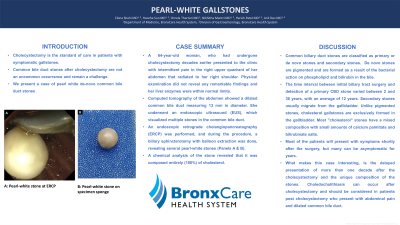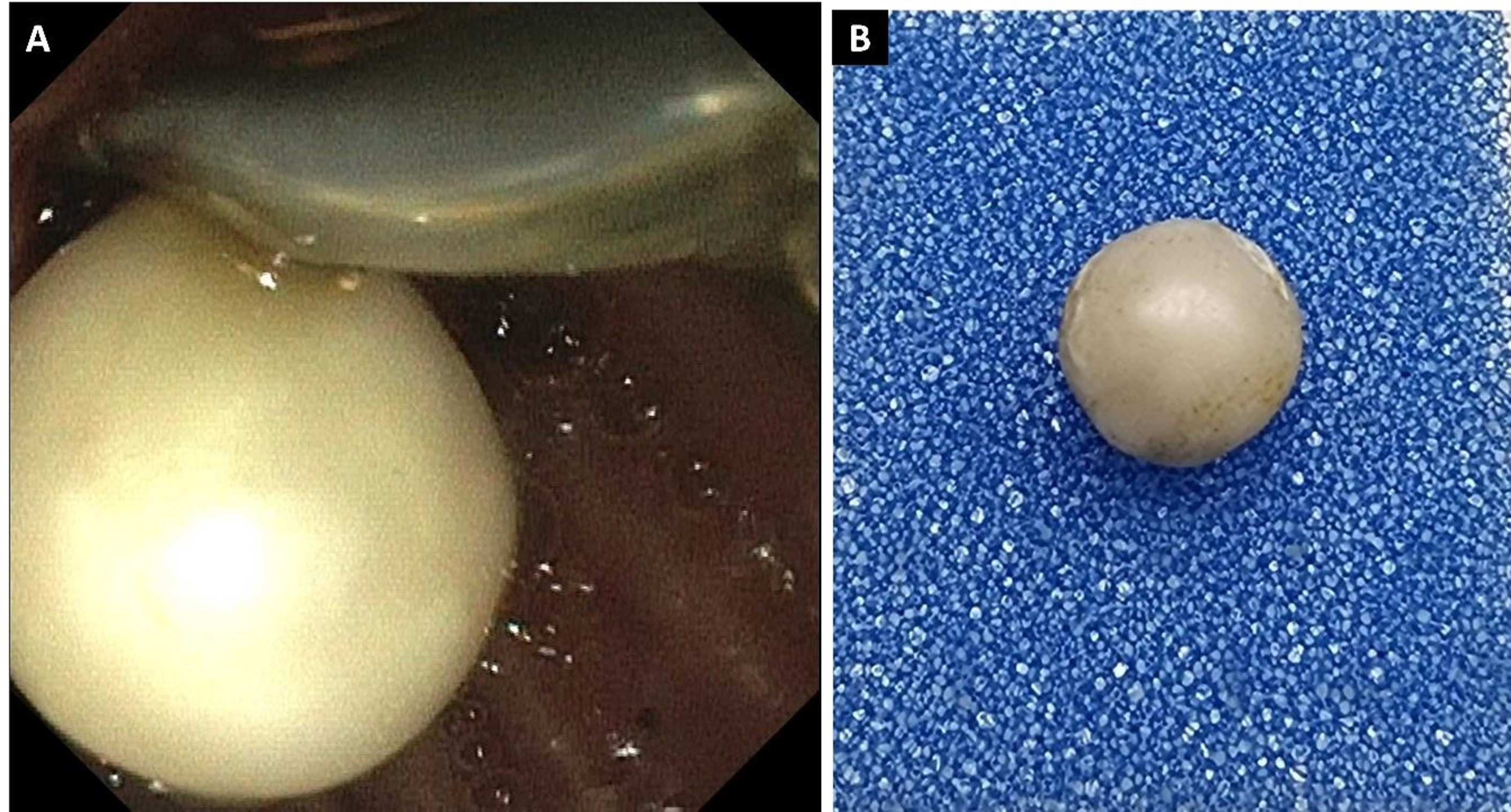Sunday Poster Session
Category: Biliary/Pancreas
P0138 - Pearl-White Gallstones
Sunday, October 22, 2023
3:30 PM - 7:00 PM PT
Location: Exhibit Hall

Has Audio
- OT
Ornela Thartori, MD
BronxCare Health System
Brooklyn, New York
Presenting Author(s)
Elona Shehi, MD1, Orlena Thartori, MD2, Haozhe Sun, MD3, Nikhitha Mantri, MD4, Harish Patel, FACG5, Anil Dev, MD6
1BronxCare Hospital, Bronx, NY; 2BronxCare Health System, Brooklyn, NY; 3BronxCare Health System, Bronx, NY; 4Bronx Lebanon Hospital Center, Bronx, NY; 5BronxCare Hospital Center, Bronx, NY; 6BCHC, Bronx, NY
Introduction: Cholecystectomy is the standard of care in patients with symptomatic gallstones. Common bile duct stones after cholecystectomy are not an uncommon occurrence and remain a challenge. We present a case of pearl-white de-novo common bile duct stones.
Case Description/Methods: A 64-year-old woman, who had undergone cholecystectomy decades earlier presented to the clinic with intermittent pain in the right upper quadrant of her abdomen that radiated to her right shoulder. Physical examination did not reveal any remarkable findings and her liver enzymes were within normal limits. Computed tomography of the abdomen showed a dilated common bile duct measuring 13 mm in diameter. She underwent an endoscopic ultrasound (EUS), which visualized multiple stones in the common bile duct. An endoscopic retrograde cholangiopancreatography (ERCP) was performed, and during the procedure, a biliary sphincterotomy with balloon extraction was done, revealing several pearl-white stones (Panels A & B). A chemical analysis of the stone revealed that it was composed entirely (100%) of cholesterol.
Discussion: Common biliary duct stones are classified as primary or de novo stones and secondary stones. De novo stones are pigmented and are formed as a result of the bacterial action on phospholipid and bilirubin in the bile. Saharia et al. reported that the time interval between initial biliary tract surgery and detection of a primary CBD stone varied between 2 and 36 years, with an average of 12 years. Secondary stones usually migrate from the gallbladder. Unlike pigmented stones, cholesterol gallstones are exclusively formed in the gallbladder. Most "cholesterol" stones have a mixed composition with small amounts of calcium palmitate and bilirubinate salts. Common bile duct stones may be overlooked and missed at the time of laparoscopic cholecystectomy, particularly when intra-operative cholangiography is not performed. Most of the patients will present with symptoms shortly after the surgery, but many can be asymptomatic for years. Cox et al, reported the median time of 4 years for patients to present with symptomatic CBD stones after laparoscopic cholecystectomy.
What makes this case interesting, is the delayed presentation of more than one decade after the cholecystectomy and the unique composition of the stones. Choledocholithiasis can occur after cholecystectomy and should be considered in patients post cholecystectomy who present with abdominal pain and dilated common bile duct.

Disclosures:
Elona Shehi, MD1, Orlena Thartori, MD2, Haozhe Sun, MD3, Nikhitha Mantri, MD4, Harish Patel, FACG5, Anil Dev, MD6. P0138 - Pearl-White Gallstones, ACG 2023 Annual Scientific Meeting Abstracts. Vancouver, BC, Canada: American College of Gastroenterology.
1BronxCare Hospital, Bronx, NY; 2BronxCare Health System, Brooklyn, NY; 3BronxCare Health System, Bronx, NY; 4Bronx Lebanon Hospital Center, Bronx, NY; 5BronxCare Hospital Center, Bronx, NY; 6BCHC, Bronx, NY
Introduction: Cholecystectomy is the standard of care in patients with symptomatic gallstones. Common bile duct stones after cholecystectomy are not an uncommon occurrence and remain a challenge. We present a case of pearl-white de-novo common bile duct stones.
Case Description/Methods: A 64-year-old woman, who had undergone cholecystectomy decades earlier presented to the clinic with intermittent pain in the right upper quadrant of her abdomen that radiated to her right shoulder. Physical examination did not reveal any remarkable findings and her liver enzymes were within normal limits. Computed tomography of the abdomen showed a dilated common bile duct measuring 13 mm in diameter. She underwent an endoscopic ultrasound (EUS), which visualized multiple stones in the common bile duct. An endoscopic retrograde cholangiopancreatography (ERCP) was performed, and during the procedure, a biliary sphincterotomy with balloon extraction was done, revealing several pearl-white stones (Panels A & B). A chemical analysis of the stone revealed that it was composed entirely (100%) of cholesterol.
Discussion: Common biliary duct stones are classified as primary or de novo stones and secondary stones. De novo stones are pigmented and are formed as a result of the bacterial action on phospholipid and bilirubin in the bile. Saharia et al. reported that the time interval between initial biliary tract surgery and detection of a primary CBD stone varied between 2 and 36 years, with an average of 12 years. Secondary stones usually migrate from the gallbladder. Unlike pigmented stones, cholesterol gallstones are exclusively formed in the gallbladder. Most "cholesterol" stones have a mixed composition with small amounts of calcium palmitate and bilirubinate salts. Common bile duct stones may be overlooked and missed at the time of laparoscopic cholecystectomy, particularly when intra-operative cholangiography is not performed. Most of the patients will present with symptoms shortly after the surgery, but many can be asymptomatic for years. Cox et al, reported the median time of 4 years for patients to present with symptomatic CBD stones after laparoscopic cholecystectomy.
What makes this case interesting, is the delayed presentation of more than one decade after the cholecystectomy and the unique composition of the stones. Choledocholithiasis can occur after cholecystectomy and should be considered in patients post cholecystectomy who present with abdominal pain and dilated common bile duct.

Figure: A: Pearl-white stone at ERCP; B: Pearl-white stone on specimen sponge
Disclosures:
Elona Shehi indicated no relevant financial relationships.
Orlena Thartori indicated no relevant financial relationships.
Haozhe Sun indicated no relevant financial relationships.
Nikhitha Mantri indicated no relevant financial relationships.
Harish Patel indicated no relevant financial relationships.
Anil Dev indicated no relevant financial relationships.
Elona Shehi, MD1, Orlena Thartori, MD2, Haozhe Sun, MD3, Nikhitha Mantri, MD4, Harish Patel, FACG5, Anil Dev, MD6. P0138 - Pearl-White Gallstones, ACG 2023 Annual Scientific Meeting Abstracts. Vancouver, BC, Canada: American College of Gastroenterology.

